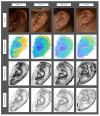Biometric Security: A Novel Ear Recognition Approach Using a 3D Morphable Ear Model
- PMID: 36433582
- PMCID: PMC9693311
- DOI: 10.3390/s22228988
Biometric Security: A Novel Ear Recognition Approach Using a 3D Morphable Ear Model
Abstract
Biometrics is a critical component of cybersecurity that identifies persons by verifying their behavioral and physical traits. In biometric-based authentication, each individual can be correctly recognized based on their intrinsic behavioral or physical features, such as face, fingerprint, iris, and ears. This work proposes a novel approach for human identification using 3D ear images. Usually, in conventional methods, the probe image is registered with each gallery image using computational heavy registration algorithms, making it practically infeasible due to the time-consuming recognition process. Therefore, this work proposes a recognition pipeline that reduces the one-to-one registration between probe and gallery. First, a deep learning-based algorithm is used for ear detection in 3D side face images. Second, a statistical ear model known as a 3D morphable ear model (3DMEM), was constructed to use as a feature extractor from the detected ear images. Finally, a novel recognition algorithm named you morph once (YMO) is proposed for human recognition that reduces the computational time by eliminating one-to-one registration between probe and gallery, which only calculates the distance between the parameters stored in the gallery and the probe. The experimental results show the significance of the proposed method for a real-time application.
Keywords: 3D morphable model; detection; ear biometrics; recognition.
Conflict of interest statement
The authors declare no conflict of interest.
Figures






References
-
- Zhao W., Chellappa R., Phillips P.J., Rosenfeld A. Face recognition: A literature survey. ACM Comput. Surv. (CSUR) 2003;35:399–458. doi: 10.1145/954339.954342. - DOI
-
- Maltoni D., Maio D., Jain A.K., Prabhakar S. Handbook of Fingerprint Recognition. Springer Science & Business Media; Berlin/Heidelberg, Germany: 2009.
-
- Lu G., Zhang D., Wang K. Palmprint recognition using eigenpalms features. Pattern Recognit. Lett. 2003;24:1463–1467. doi: 10.1016/S0167-8655(02)00386-0. - DOI
-
- Chen H., Bhanu B. Contour matching for 3D ear recognition; Proceedings of the 2005 Seventh IEEE Workshops on Applications of Computer Vision (WACV/MOTION’05); Breckenridge, CO, USA. 5–7 January 2005; pp. 123–128.
MeSH terms
LinkOut - more resources
Full Text Sources

